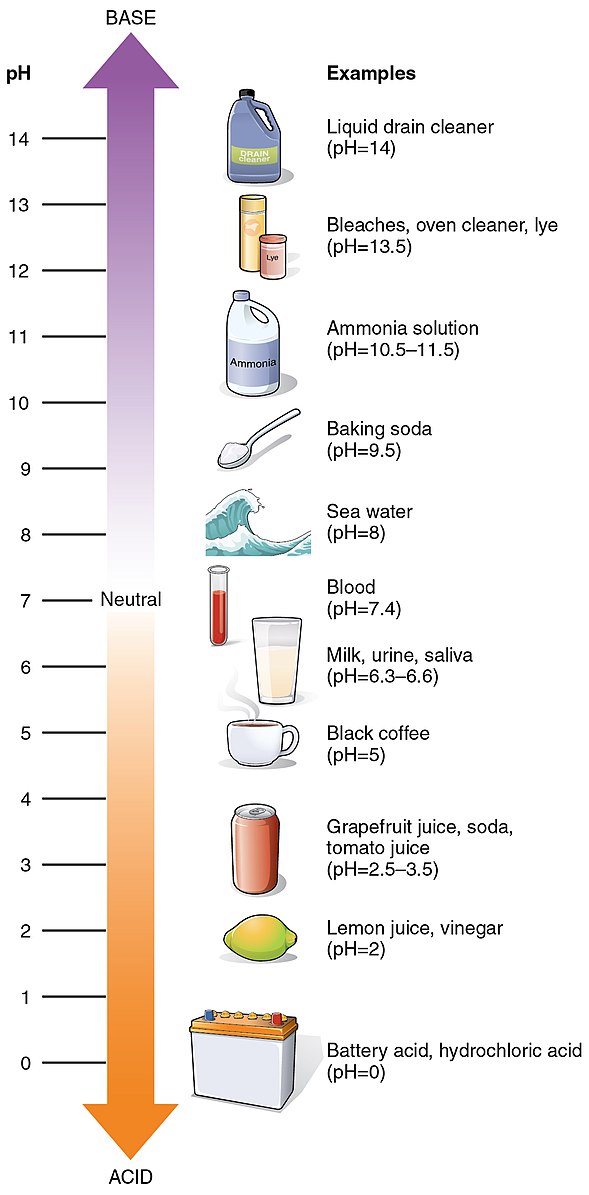The pH of a solution containing silicon tetrachloride (SiCl4) in water is acidic due to the irreversible hydrolysis of SiCl4, forming hydrochloric acid (HCl) and silica gel (Si(OH)4). This article will explore the chemical reactions, factors affecting the pH, and the implications of the acidic nature of the solution.
Understanding the Hydrolysis of SiCl4
When SiCl4 is added to water, it undergoes an irreversible hydrolysis reaction, as shown in the following equation:
SiCl4 + 2H2O → Si(OH)4 + 4HCl
In this reaction, the silicon tetrachloride (SiCl4) reacts with water (H2O) to form silicic acid (Si(OH)4) and hydrochloric acid (HCl). The release of HCl is the primary reason for the acidic nature of the solution.
The silicic acid (Si(OH)4) produced in this reaction exists in the form of silica gel (SiO2·2H2O), which is a solid material that can be separated from the solution.
Factors Affecting the pH of the Solution
 Image source: OpenStax College
Image source: OpenStax College
The pH of the solution containing SiCl4 in water is influenced by several factors, including:
-
Concentration of SiCl4: The higher the concentration of SiCl4 in the solution, the more HCl will be produced, resulting in a lower pH.
-
Volume of Water: The amount of water present in the solution can also affect the pH. A higher volume of water will dilute the HCl, leading to a higher pH.
-
Temperature: The hydrolysis reaction is exothermic, meaning it releases heat. Increasing the temperature can shift the equilibrium of the reaction, potentially affecting the pH.
-
Presence of Buffers: The addition of buffers, such as sodium hydroxide (NaOH), can help neutralize the acidity and maintain a desired pH level.
Calculating the pH of the Solution
To calculate the pH of the solution, we can use the following steps:
- Determine the concentration of HCl produced in the hydrolysis reaction.
- Calculate the hydrogen ion concentration ([H+]) using the formula: [H+] = 10^(-pH).
- Solve for the pH using the formula: pH = -log([H+]).
For example, if the initial concentration of SiCl4 is 0.1 M and the volume of water is 1 L, the concentration of HCl produced would be 0.4 M. Plugging this into the pH calculation, the resulting pH would be approximately 0.4.
Neutralizing the Acidic Solution
To neutralize the acidic solution, a base such as sodium hydroxide (NaOH) can be added. The reaction between HCl and NaOH produces sodium chloride (NaCl) and water, as shown in the following equation:
HCl + NaOH → NaCl + H2O
The amount of NaOH required to neutralize the solution will depend on the concentration of HCl present, which is directly related to the initial concentration of SiCl4.
Potential Contaminants and Impurities
In addition to HCl and Si(OH)4, the solution containing SiCl4 in water may also contain other contaminants and impurities, such as:
- Unreacted SiCl4
- Trace metals or other impurities present in the original SiCl4 sample
- Byproducts of side reactions
These contaminants and impurities can be removed through various purification techniques, such as filtration, distillation, or ion exchange.
Alternative Approaches
As an alternative to using SiCl4, other silicon-based compounds that are less hazardous and corrosive can be used. For example, silicon dioxide (SiO2) is a common starting material in the production of semiconductors and other electronic components.
Conclusion
The pH of a solution containing SiCl4 in water is acidic due to the formation of hydrochloric acid (HCl) during the irreversible hydrolysis of SiCl4. The exact pH of the solution depends on factors such as the concentration of SiCl4, the volume of water, and the presence of buffers. To neutralize the acidic solution, a base such as sodium hydroxide (NaOH) can be added. Additionally, the solution may contain other contaminants and impurities that need to be addressed through appropriate purification techniques. As an alternative, less hazardous silicon-based compounds can be used in various applications.
References:
– Silicon tetrachloride – TutorChase
– pH of solution after adding SiCl4 – Chemistry Stack Exchange
– PERIODICITY 2 [IB] – IB Chemistry
– the period 3 chlorides – Chemguide
